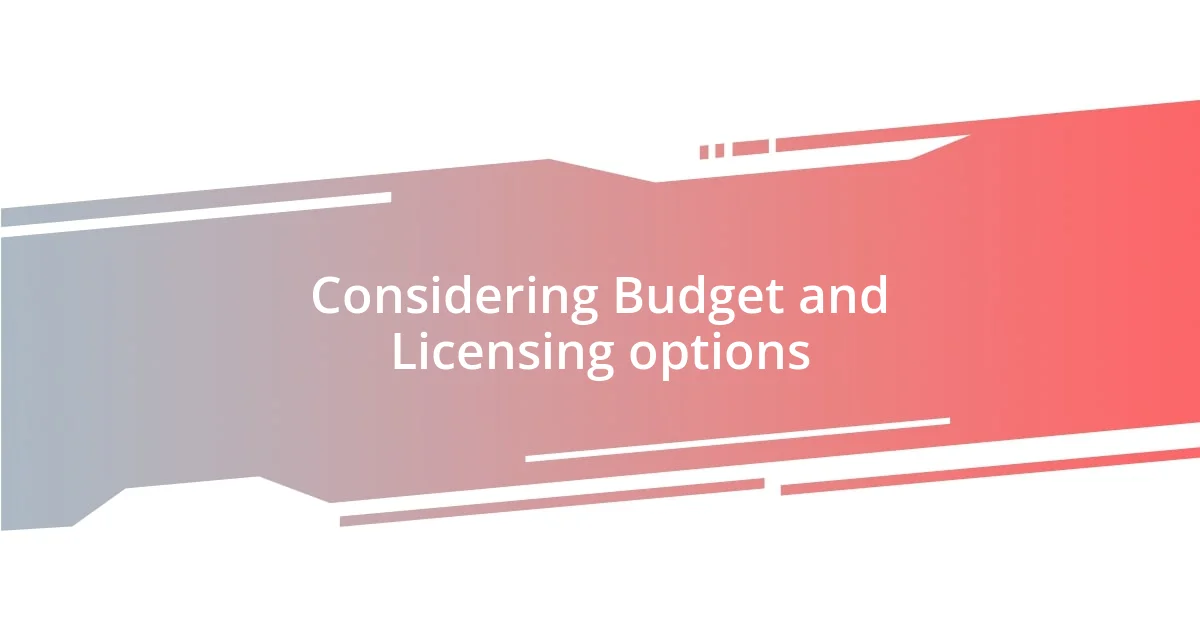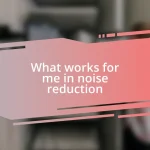Key takeaways:
- Understanding music production goals is crucial for selecting the right DAW, focusing on aspects like genre, collaboration, and production techniques.
- Evaluating features, user interface, and community support of different DAWs can significantly impact productivity and creative flow.
- Testing DAWs through free trials, considering budget and licensing options, and reading reviews helps ensure a well-informed decision-making process.

Understanding Digital Audio Workstations
Digital Audio Workstations, or DAWs, are incredible tools that empower musicians, producers, and audio engineers to create and manipulate sound. I remember the first time I opened a DAW; it felt like stepping into a new universe where the possibilities were endless. Have you ever felt that excitement when discovering a new technology?
At their core, DAWs function like a digital version of traditional recording studios, allowing users to record, edit, mix, and produce audio files all from one platform. I still recall the countless hours I spent experimenting with various DAWs, trying to understand how each one approached functionality and workflow. It’s fascinating how even the smallest changes in layout can alter how you feel while working on a project, don’t you think?
There are many types of DAWs available, each tailored for different needs—some prioritize MIDI sequencing, while others focus on audio recording. I’ve found that selecting the right DAW greatly influenced my creativity and productivity; it’s like finding the right instrument that resonates with your musical style. If you’ve ever switched software, you might relate to the unique challenge of adapting your workflow, but ultimately, it can lead to newfound inspiration.

Identifying Your Music Production Goals
Identifying your music production goals is a crucial step in selecting the right DAW. For me, it was illuminating to assess whether I wanted to create electronic beats, record live instruments, or focus on film scoring. Understanding this helped narrow down my options, making the decision feel more focused and less overwhelming.
Consider these key aspects when outlining your goals:
- Genre Focus: What style of music do you primarily want to produce?
- Collaboration Needs: Will you be working with others, or is it a solo project?
- Production Techniques: Do you want to emphasize MIDI programming, audio manipulation, or a mix of both?
- Platform Preference: Are you more comfortable on a PC or Mac?
- Learning Curve: How much time are you willing to invest in learning new software?
Reflecting on my own experience, I realized I gravitated towards a DAW that combined audio and MIDI capabilities seamlessly. This choice not only matched my style but also fueled my creativity, allowing me to explore new techniques effortlessly. Ultimately, defining clear production goals helps you find a DAW that feels like an extension of your creative process.

Evaluating DAW Features and Functions
Evaluating the features and functions of different DAWs is essential. I find that features like audio editing capabilities, MIDI support, and built-in plugins can make or break my experience. For instance, when I switched from one DAW to another, I quickly noticed how certain audio editing tools could save me precious hours—hours I’d rather spend creating music than wrestling with clunky interfaces.
It’s also vital to consider the learning curve associated with each DAW. My first experience with a complex DAW left me overwhelmed, but as I grew more familiar with the software, I appreciated its depth. Features like customizable workflows and intuitive keyboard shortcuts can dramatically enhance productivity. Have you ever become frustrated with a tool that just didn’t feel right? I certainly have, and it’s taught me to prioritize user-friendliness in my evaluation process.
Lastly, I encourage you to look at community support and resources available for each DAW. When I chose my current DAW, I was pleasantly surprised to find tutorials, forums, and user groups that made my transition smoother. This support network is invaluable, especially when you’re eager to learn new techniques or troubleshoot issues. Taking the time to compare these features across different DAWs can significantly influence your decision.
| Feature | Importance |
|---|---|
| Audio Editing | Essential for mixing and manipulating recorded sounds |
| MIDI Support | Key for electronic music production and composing |
| User Interface | Affects workflow efficiency and ease of use |
| Built-in Plugins | Enhances sound design and production capabilities |
| Community Support | Helpful for learning and troubleshooting |

Comparing Workflow and User Interface
When comparing workflows and user interfaces, I often reflect on how each DAW makes me feel while working. Some DAWs have a streamlined interface that encourages creativity, while others can feel cluttered and overwhelming. I remember the first time I tried a notoriously complex DAW; I spent so much time searching for tools that my music ideas felt stifled. Have you ever encountered a software that just didn’t vibe with your creative flow? It can be frustrating.
In my experience, an intuitive user interface is a game-changer. I once switched to a DAW that offered a customizable workspace, allowing me to arrange tools in a way that felt natural to me. This small change drastically improved my workflow, making it easy to transition between tasks without losing my creative momentum. I can’t stress enough how a well-designed interface can turn music production from a chore into an enjoyable process.
Another key aspect to consider is how the DAW’s workflow aligns with your unique style. For instance, when I produce electronic music, I prefer a program that facilitates quick MIDI programming and easy access to virtual instruments. A DAW that allows me to swiftly navigate between different sections of a track helps maintain my inspiration, ensuring my ideas flow freely without getting bogged down by technical hurdles. This brings me to the importance of trying out demos—because the right fit may surprise you. How well does your current DAW meet your personal workflow needs?

Testing DAWs with Free Trials
Testing out DAWs through free trials has been a crucial step in my decision-making process. I remember downloading a trial version of a DAW that came highly recommended but found myself frustrated when the workflow didn’t mesh with my creative style. It was like trying to fit a square peg into a round hole—no matter how much I wanted to love it, it just wasn’t the right fit.
Taking the time to dive into the free versions allows me to explore their unique features and see how they align with my needs. I often make a checklist of must-have functionalities, and during my trials, I play around with audio editing tools, MIDI capabilities, and plugins. Have you ever found yourself lost in a new DAW, testing its limits and capabilities? I certainly have, and it’s during those exploratory sessions that I truly get a feel for the software.
Moreover, those free trials often come with limitations, which can be a double-edged sword. I recall trying a DAW that restricted my access to certain plugins. Initially, it felt like a setback, but it pushed me to discover more about the core functionality without relying too heavily on external resources. This experience helped me appreciate the essential features and confirm that I needed a DAW that offers comprehensive audio editing and MIDI functions right out of the gate. Sometimes, fewer options can lead to deeper learning—don’t you think?

Considering Budget and Licensing options
When it comes to picking the right DAW, budget and licensing options can make a significant difference. I can recall the first time I explored various pricing tiers; it felt like navigating a maze. Some DAWs offer a one-time purchase option, while others operate on a subscription model. Personally, I prefer subscriptions because they often include regular updates and new features, keeping my tools current without the hefty upfront cost. What’s your take on ongoing subscriptions versus owning software outright?
In my experience, it’s vital to assess what you can afford without compromising your creative ambitions. I once splurged on a DAW that included a vast array of plugins, only to realize later that I wasn’t using half of them. It’s like filling your toolbox with fancy gadgets that you never touch! Knowing the specific features you need can help you make a more informed decision, ensuring you invest wisely. Have you ever felt pressured to buy the “best” and regretted it later?
Licensing types also affect how you can use your DAW. Some licenses may restrict your ability to install the software on multiple devices, which can be limiting if you like to work on the go. I remember feeling stifled by such restrictions when I switched laptops and realized my DAW was tied to my old machine. Exploring flexible licensing options has been a game-changer for me; now, I can create music anytime inspiration strikes. Aren’t you curious about how different licensing structures might impact your workflow and creativity?

Reading Reviews and User Feedback
Reading reviews and user feedback is an essential part of my decision-making when choosing a DAW. I often find myself scrolling through forums and review sites, taking note of both positive and negative experiences shared by others. One particularly memorable instance was when I read a review praising the user-friendly interface of a DAW I was considering. Hearing real users describe how intuitive it felt made me more inclined to give it a try myself. Do you consider what others say to help shape your opinions?
User feedback can reveal nuances that technical specs sometimes miss. I remember stumbling upon a user who had experienced frustrating crashes while using a specific DAW during recording sessions. This kind of firsthand account made me rethink my initial excitement. It’s these insights that often tip the scales for me; have you ever paused and reconsidered a purchase because of something you read?
Moreover, I pay close attention to recurring themes in reviews, as they often indicate consistent strengths or weaknesses. For example, I once noticed several users mention how a DAW’s support community played a big role in their success. That got me thinking—having a solid support network can be just as important as the software itself. It’s not just about the tool; it’s about the ecosystem around it. What’s your experience with support systems in music production?















